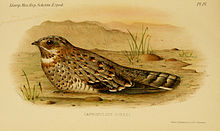Nubian nightjar
| Nubian nightjar | |
|---|---|

| |
| Illustration by Henrik Grönvold of the subspecies jonesi | |
| Scientific classification | |
| Kingdom: | Animalia |
| Phylum: | Chordata |
| Class: | Aves |
| Order: | Caprimulgiformes |
| Family: | Caprimulgidae |
| Genus: | Caprimulgus |
| Species: | C. nubicus
|
| Binomial name | |
| Caprimulgus nubicus Lichtenstein, 1823
| |
The Nubian nightjar (Caprimulgus nubicus) is a species of nightjar in the family Caprimulgidae. It is found in Djibouti, Egypt, Eritrea, Ethiopia, Israel, Kenya, Oman, Saudi Arabia, Somalia, Sudan, and Yemen.
Description[]
The Nubian nightjar is 20–22 cm long. The bird resembles the Moorish nightjar, but is smaller, has a shorter tail and blunt wings compared to the ̺Moorish nightjar. Another characteristic feature is a red-brown band over the neck. The white wing spots are not further away from the wing tips than other types of nightjars.[2] The Nubian nightjar (Caprimulgus nubicus, Lichtenstein 1823) is the smallest and slightest nightjar in the Western Palearctic (Snow & Perrins, 1998). The species is relatively widespread in the arid part of eastern Africa, though recorded as uncommon and scarce (Perlman, 2008). In the Middle East, it was reported along the Rift Valley in southern Palestine and the Red Sea coast of southern Arabian Peninsula (Birdlife International, 2012). The Nubian nightjar is a nocturnal species, known for its large eyes and beak, which help it hunt at night. The bird's former range included the Dead Sea, Aqaba, Fidan Valley, and Tassan, but it is now restricted to Fifa Nature Reserve as a result of habitat destruction (RSCN).
References[]
- ^ BirdLife International (2016). "Caprimulgus nubicus". IUCN Red List of Threatened Species. 2016: e.T22689912A93252462. doi:10.2305/IUCN.UK.2016-3.RLTS.T22689912A93252462.en. Retrieved 11 November 2021.
- ^ Mullarny, K. et al., 1999. ANWB Vogelgids van Europa, Tirion, Baarn. ISBN 90-18-01212-2
- Kirwan, Guy M. (2004). "Some remarks on the taxonomy of Nubian Nightjar Caprimulgus nubicus, with particular reference to C. n. jonesi Ogilvie-Grant & Forbes, 1899" (PDF). Bulletin of the African Bird Club. 11 (2): 117–125. doi:10.5962/p.309720. Retrieved 20 August 2010.
- IUCN Red List least concern species
- Caprimulgus
- Birds of East Africa
- Birds of the Middle East
- Birds described in 1823
- Caprimulgiformes stubs
